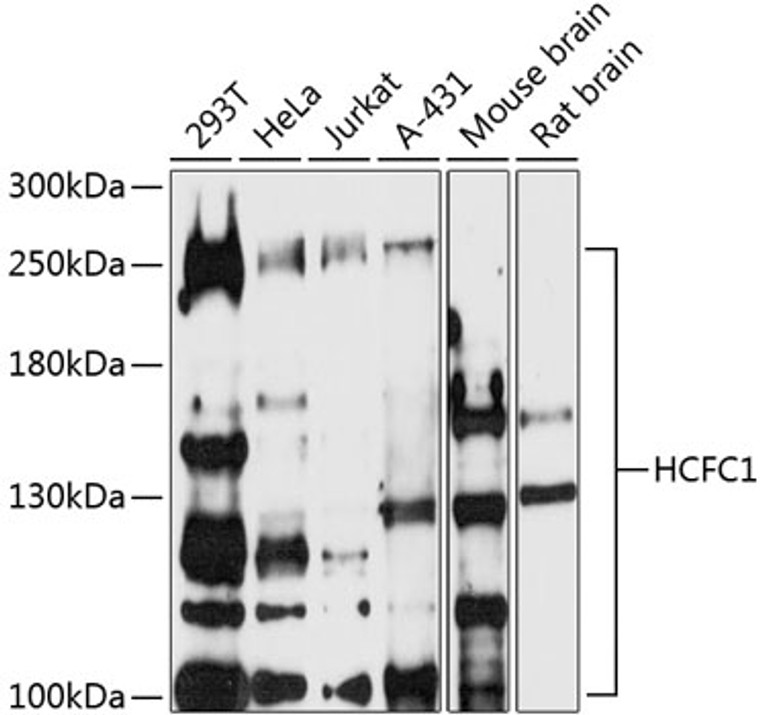| Host: |
Rabbit |
| Applications: |
WB |
| Reactivity: |
Human/Mouse/Rat |
| Note: |
STRICTLY FOR FURTHER SCIENTIFIC RESEARCH USE ONLY (RUO). MUST NOT TO BE USED IN DIAGNOSTIC OR THERAPEUTIC APPLICATIONS. |
| Short Description: |
Rabbit polyclonal antibody anti-HCFC1 (1-250) is suitable for use in Western Blot research applications. |
| Clonality: |
Polyclonal |
| Conjugation: |
Unconjugated |
| Isotype: |
IgG |
| Formulation: |
PBS with 0.02% Sodium Azide, 50% Glycerol, pH7.3. |
| Purification: |
Affinity purification |
| Dilution Range: |
WB 1:500-1:2000 |
| Storage Instruction: |
Store at-20°C for up to 1 year from the date of receipt, and avoid repeat freeze-thaw cycles. |
| Gene Symbol: |
HCFC1 |
| Gene ID: |
3054 |
| Uniprot ID: |
HCFC1_HUMAN |
| Immunogen Region: |
1-250 |
| Immunogen: |
Recombinant fusion protein containing a sequence corresponding to amino acids 1-250 of human HCFC1 (NP_005325.2). |
| Immunogen Sequence: |
MASAVSPANLPAVLLQPRWK RVVGWSGPVPRPRHGHRAVA IKELIVVFGGGNEGIVDELH VYNTATNQWFIPAVRGDIPP GCAAYGFVCDGTRLLVFGGM VEYGKYSNDLYELQASRWEW KRLKAKTPKNGPPPCPRLGH SFSLVGNKCYLFGGLANDSE DPKNNIPRYLNDLYILELRP GSGVVAWDIPITYGVLPPPR ESHTAVVYTEKDNKKSKLVI YGGMSGCRLGDLWTLDIDT |
| Tissue Specificity | Highly expressed in fetal tissues and the adult kidney. Present in all tissues tested. |
| Post Translational Modifications | Proteolytically cleaved at one or several PPCE--THET sites within the HCF repeats. Further cleavage of the primary N- and C-terminal chains results in a 'trimming' and accumulation of the smaller chains. Cleavage is promoted by O-glycosylation. O-glycosylated. GlcNAcylation by OGT promotes proteolytic processing. Ubiquitinated. Lys-1807 and Lys-1808 are ubiquitinated both via 'Lys-48'- and 'Lys-63'-linked polyubiquitin chains. BAP1 mediated deubiquitination of 'Lys-48'-linked polyubiquitin chains.deubiquitination by BAP1 does not seem to stabilize the protein. |
| Function | Transcriptional coregulator. Involved in control of the cell cycle. Also antagonizes transactivation by ZBTB17 and GABP2.represses ZBTB17 activation of the p15(INK4b) promoter and inhibits its ability to recruit p300. Coactivator for EGR2 and GABP2. Tethers the chromatin modifying Set1/Ash2 histone H3 'Lys-4' methyltransferase (H3K4me) and Sin3 histone deacetylase (HDAC) complexes (involved in the activation and repression of transcription, respectively) together. Component of a THAP1/THAP3-HCFC1-OGT complex that is required for the regulation of the transcriptional activity of RRM1. As part of the NSL complex it may be involved in acetylation of nucleosomal histone H4 on several lysine residues. Recruits KMT2E/MLL5 to E2F1 responsive promoters promoting transcriptional activation and thereby facilitates G1 to S phase transition. Modulates expression of homeobox protein PDX1, perhaps acting in concert with transcription factor E2F1, thereby regulating pancreatic beta-cell growth and glucose-stimulated insulin secretion. May negatively modulate transcriptional activity of FOXO3. (Microbial infection) In case of human herpes simplex virus (HSV) infection, HCFC1 forms a multiprotein-DNA complex with the viral transactivator protein VP16 and POU2F1 thereby enabling the transcription of the viral immediate early genes. |
| Protein Name | Host Cell Factor 1HcfHcf-1C1 FactorCffVcafVp16 Accessory Protein Cleaved Into - Hcf N-Terminal Chain 1 - Hcf N-Terminal Chain 2 - Hcf N-Terminal Chain 3 - Hcf N-Terminal Chain 4 - Hcf N-Terminal Chain 5 - Hcf N-Terminal Chain 6 - Hcf C-Terminal Chain 1 - Hcf C-Terminal Chain 2 - Hcf C-Terminal Chain 3 - Hcf C-Terminal Chain 4 - Hcf C-Terminal Chain 5 - Hcf C-Terminal Chain 6 |
| Database Links | Reactome: R-HSA-2151201Reactome: R-HSA-3214847Reactome: R-HSA-5689603Reactome: R-HSA-9772755 |
| Cellular Localisation | CytoplasmNucleusHcfc1r1 Modulates Its Subcellular Localization And Overexpression Of Hcfc1r1 Leads To Accumulation Of Hcfc1 In The CytoplasmNon-Processed Hcfc1 Associates With ChromatinColocalizes With Creb3 And Canx In The Er |
| Alternative Antibody Names | Anti-Host Cell Factor 1 antibodyAnti-Hcf antibodyAnti-Hcf-1 antibodyAnti-C1 Factor antibodyAnti-Cff antibodyAnti-Vcaf antibodyAnti-Vp16 Accessory Protein Cleaved Into - Hcf N-Terminal Chain 1 - Hcf N-Terminal Chain 2 - Hcf N-Terminal Chain 3 - Hcf N-Terminal Chain 4 - Hcf N-Terminal Chain 5 - Hcf N-Terminal Chain 6 - Hcf C-Terminal Chain 1 - Hcf C-Terminal Chain 2 - Hcf C-Terminal Chain 3 - Hcf C-Terminal Chain 4 - Hcf C-Terminal Chain 5 - Hcf C-Terminal Chain 6 antibodyAnti-HCFC1 antibodyAnti-HCF1 antibodyAnti-HFC1 antibody |
Information sourced from Uniprot.org
12 months for antibodies. 6 months for ELISA Kits. Please see website T&Cs for further guidance







